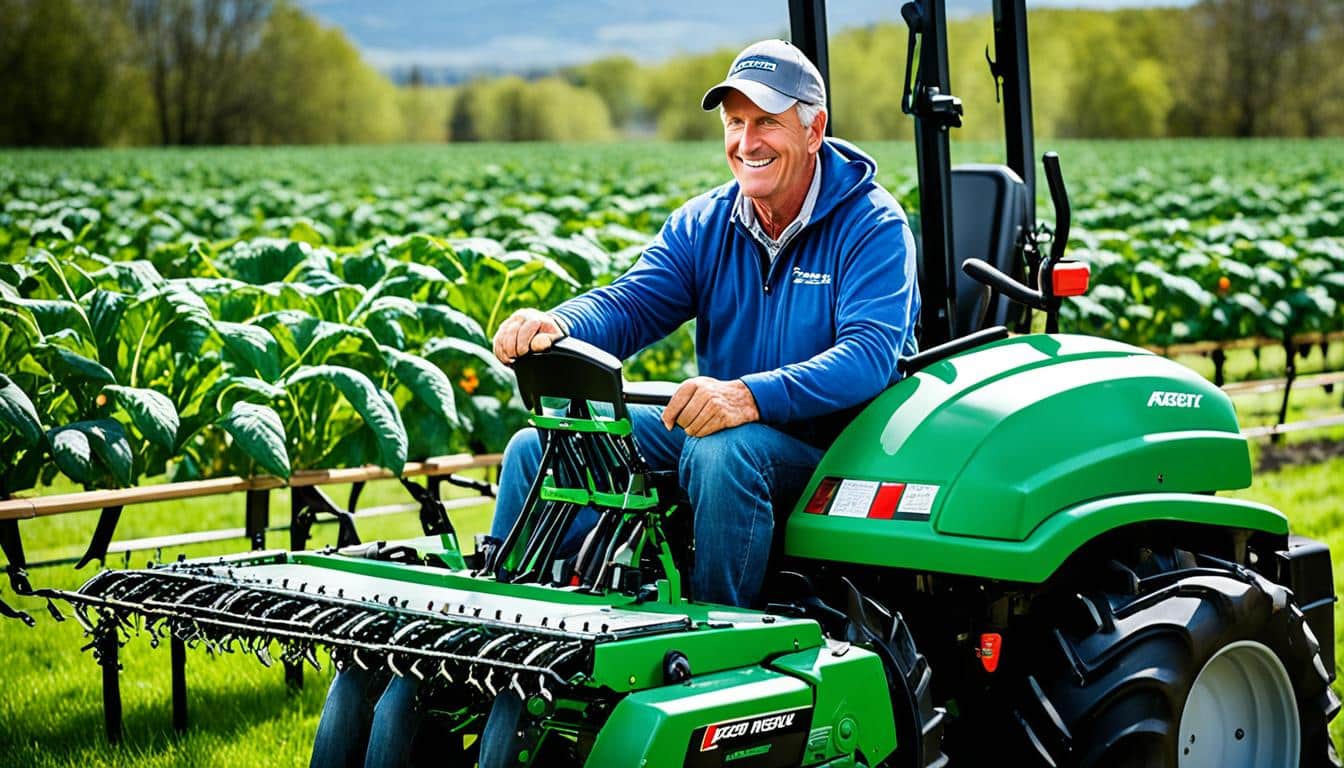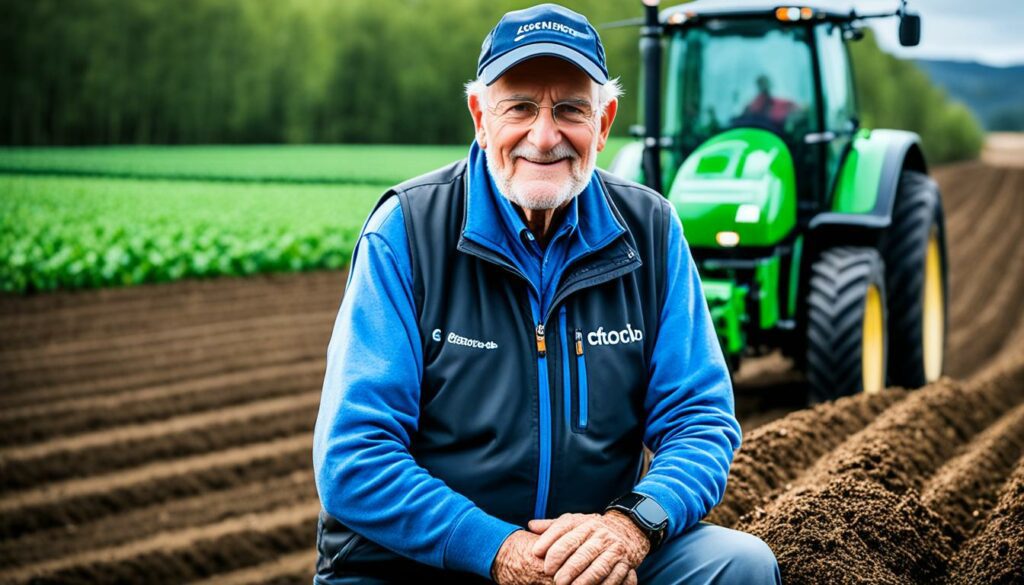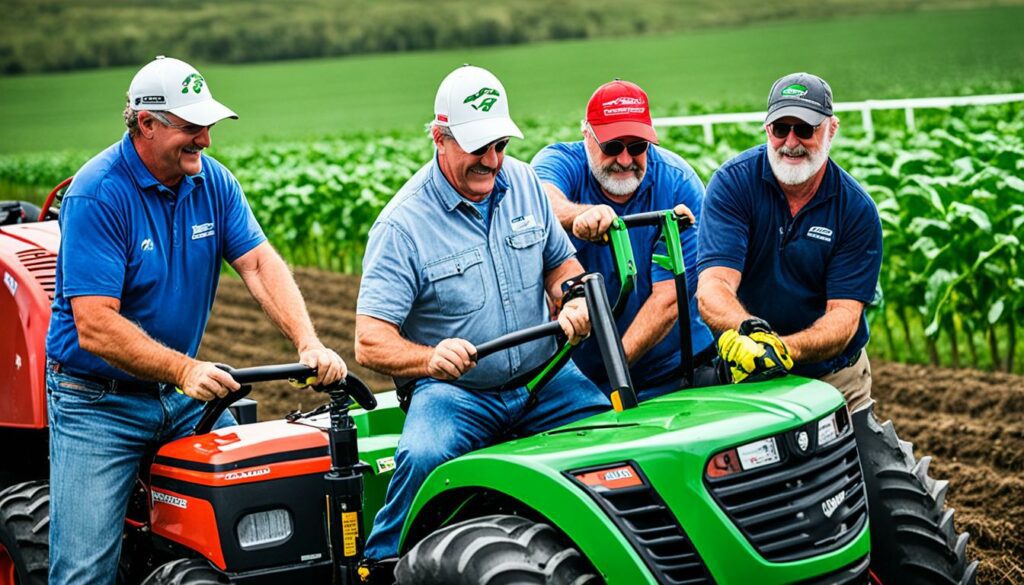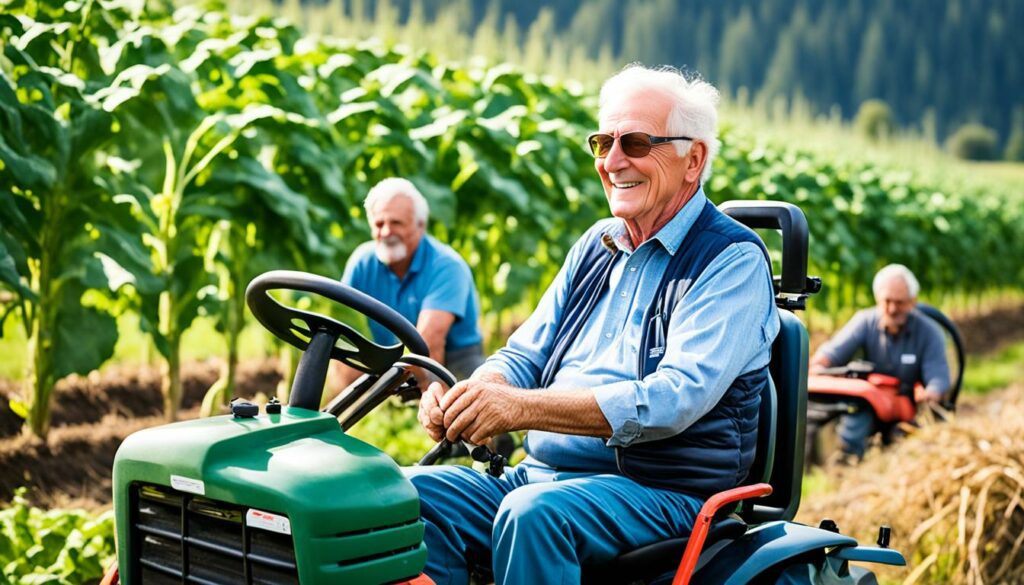Menu

Back injuries make up about a quarter of all farm worker injuries, costing over $22 million in California every year. This huge cost shows the heavy toll on our older farmers. It shows why we need ergonomic farming gear and tools to help.
As farmers grow older, they find it harder to do tough, repetitive jobs. Ergonomic solutions are there for them. They use new ideas in farm tools to make work safer and easier. This includes everything from better handles to smart wearables made to lighten farmers’ workloads.
Modern farming has its challenges, especially for older farmers. Their bodies may not work as well as before. Ergonomic solutions are key not just to help with farm work but also to keep farmers healthy. In this section, we delve into how ergonomics is vital for agriculture and its role in farmer safety.
Put simply, ergonomics focuses on making tools and work areas suit the user’s body. This helps lower tiredness and aches. Farmers often do the same chores, which can harm their muscles and bones. Studies in Iran have shown that these issues are quite common in agriculture. Using machines for tasks like weeding cuts down on the hard work. This is why designing farm tools well is key.
Getting older affects how farmers can work, leading to health problems. Dust, loud noise, and vibrating machines can make things worse. In Korea, a large number of farmers suffered from bone and muscle issues in 2020. These conditions made up most of the farm health issues. So, making farm work safer and more comfortable is crucial for older farmers.
Improving the health of older farmers calls for a team effort between them and those who know about ergonomics. This approach has worked, like in Korea where they looked at how people worked in peach farming. They used a method called RULA to make sure any changes improved things.
Adding tech and ergonomic tools to farming not only makes it better but also keeps farmers healthy. This way, they can keep working in agriculture. Concentrating on how tools are made and used can make life much better for our older farmers.

Older farmers face many health issues due to the hard work of farming. As they get older, these problems get worse. Years of heavy lifting and doing the same actions over and over hurt their muscles and bones a lot.
Farming is tough and often leads to injuries. Many farmers hurt their backs, and others get strains. Reports show that about a third of farm injuries are from sprains and over a quarter come from back issues. This leads to a lot of back pain, shoulder problems, and sore hands because of doing the same things all the time.
As farmers get older, they suffer more from muscle and bone problems. For many, this means a lot of lower back pain. Knee and hip issues, like arthritis, also become common from all the bending and kneeling on farms.
However, there are ways to lessen these problems. Making changes like using lighter loads and tools that fit the farmer better helps a lot. For example, a study showed that a lighter tote with handles could lower pain significantly without hurting how much work gets done.
Focusing on how the farmer moves and works helps keep them healthier. This way, older farmers can stay in better shape and work longer without as many health issues.
Creating ergonomic farm tools is key to lower injuries and work better. More than a third of farm injuries are muscle sprains. A quarter are back problems. These big numbers show why we must carefully design ergonomic tools and adapt them for farm use.
Making farm tools that are ergonomic means following some important design rules. Ergonomics works to reduce stress on the body. This happens when using tools that need a tight grip, kneeling, lifting, or bending. By changing tools and how work is done, we cut down the risk of getting hurt.
For hand tools, experts suggest certain handle shapes, sizes, and materials. They also say tools should be easy to hold and shouldn’t slip. For lifting, it’s best to not lift things off the floor. Tools should have handles, and loads should be under 50 lbs.
Customising tools for each person is key in ergonomic design. Dr Aaron Yoder points out that different tools fit different body types. He says changing jobs so workers don’t have to bend over is important. Using long-handled tools, stools, or alternating sitting and walking tasks can reduce injuries a lot. These changes help not just the body, but also the mind.
Because many work injuries are due to using tools not suited to people’s bodies, fitting tools to the user is very important. This approach keeps farmers both physically and mentally healthy. The result is they work better and have a better life.
| Injury Type | Percentage of Injuries | Annual Costs (California) |
|---|---|---|
| Sprains and Strains | 33% | $22 million |
| Back Injuries | 25% | $22 million |
Assistive tools for farmers are very important. They improve work and lower the chance of getting hurt. They are especially helpful for older farmers. These tools are made to help with different tasks. This makes farming easier and less tiring.

It is key to sort assistive tools based on what they do and how they help:
AgrAbility shows how technology helps farm work. Here are some tools that make a big difference:
Having many types of assistive tools is vital for farmers. These tools make work more efficient and keep farmers healthy. They also help make farming eco-friendly.
Using ergonomic farming tools is key to boost productivity and cut down on physical stress. Dr. Aaron Yoder highlights the importance of picking ergonomic tools to fight work-related injuries. By closely looking at equipment selection criteria and real case studies on effectiveness, farmers can gain a lot.
Various factors should be considered when choosing ergonomic farming tools:
According to NIOSH, making sure tools are ergonomic is very important. This means the tools fit well with the user to lower injury risks.
Studying the case studies on effectiveness shows the benefits of using ergonomic farming equipment:
| Case Study | Modifications | Results |
|---|---|---|
| California Agriculture | Changing how tools are used and designed to improve posture and lower force. | Over 3,000 fewer back injuries a year, saving more than $22 million. |
| Physics of Farming Tools | Using sharp shovel blades and broader grips for better work. | About 20% less physical strain and better productivity with little loss of efficiency. |
These studies prove that using ergonomic farming equipment can lessen injuries and boost productivity. They make work better for the workers.
Wearable tech has a big role in making farms safer. Farming is known to be very risky. So, having good safety measures is vital.
Wearable tech offers many benefits in farming. It uses clever tech to stop accidents with farm equipment. This can also lower the chance of getting hurt. For example, exoskeletons help with back problems. Many farmers want these, as a study at Virginia Tech found.

Exoskeletons designed for farming can especially help with livestock. This work is among the most dangerous. Wearable technology makes the job easier for older farmers. They are often the ones who get hurt the most.
Knee and back exoskeletons are top choices for many. People are researching better knee support too. Besides, lots of farmers like the idea of exoskeletons that support the whole body.
Hand support devices are also key. Hands are complicated, with lots of joints. Creating strong hand exoskeletons is very important.
Farmers need wearable devices that are tough and easy to use. These devices must fit in with their work. They should be able to use them every day, even when things change.
Keeping farmers safe is very important, given the many risks they face. The farming community’s health is at stake, dealing with the tough physical challenges of their work. Shockingly, 40% of Midwestern crop farmers said they had back problems last year. What’s more, 68% of those people struggled to do their daily tasks because of the pain.
It’s crucial to know why farmers get hurt to stop it happening. The tasks that lead to back pain are many – from bending and stooping to using big farming machines and lifting heavy things. It’s no wonder many farmers report pains in their backs, shoulders, arms, and hands.
“In California agriculture alone, the annual workers’ compensation costs for over 3,000 back injuries per year may exceed $22 million,”
Health issues from farm work often stop people from working in their prime years. This is why using good design (ergonomics) to match jobs with how our bodies move is so important. This can lower the chances of getting disabled from work and improve safety greatly.
To lower risks, follow safe lifting, handwork, and tool guidelines. For example, lift things between your hand and shoulder, use containers with handles, and have dollies for moving stuff a short way. Also, try to change the way jobs are done to include less bending, add long handles to tools, and mix up tasks that require bending with others to keep things safe.
Using ergonomics in farming not only prevents injuries but also makes work more productive and comfortable. It’s key to deal with risks in farming ahead of time. This way, we can make a safer, better place for those who grow our food.
Making farms safer is key to avoid injuries and boost how much work gets done. Skilled safety measures and specific training can cut down on risks of working on a farm.

Farm tasks can be hard on the body, causing health problems. Ergonomic fixes, meant for the job at hand, aim to fight these risks. They make work positions better and cut down on strain, lowering the chance of getting hurt. Using special tools and methods this way can lower the risk of getting hurt at work.
| Type of Injury | Percentage | Cost in California (annually) |
|---|---|---|
| Sprains and Strains | 33% | Included in total |
| Back Injuries | 25% | $22 million |
| Others | 42% | Included in total |
Doing safety checks often, designing tools for comfort, and making fitting ergonomic plans are vital. Concentrating on ergonomics means our tools and methods fit what our bodies can do. This makes things safer, more comfy, and helps us work better.
Training staff well on how to stay safe is crucial for farm safety. This covers the right ways to work with farm gear. It also includes how to lift safely, use special tools, and keep a good posture. Training in many languages means everyone gets to learn how to work safely, no matter what language they speak.
Adding worker ideas and discussions to training on safety tools enhance safety. It gets everyone more involved and makes safety a part of daily farm life.
Using new technology, like machinery sensors that spot problems, is also important. These tech tools help find issues early, making the farm a safer place to work.
Sustainable farming is key for lasting agriculture. It helps the world, boosts farm income, and improves life for people in farming. I’ll explain why being sustainable is so important.
Sustainability in farming is vital. It saves resources, cuts waste, and keeps farming possible for the future. These efforts protect nature and help farm workers stay healthy. The farming sector often sees injuries and health issues. Musculoskeletal disorders are common, but sustainable methods can make work safer. They reduce the chance of injury and cut down on hard physical work.
Worldwide, many ideas are helping farming be more sustainable:
Ergonomic improvements in farming can reduce pain a lot, even with small changes. These efforts help farming be sustainable and make farm work safer. They lower the chance of conditions like back pain and osteoarthritis, which are common in older farmworkers.
| Practice | Benefits |
|---|---|
| Crop Rotation | Enhances soil nutrients, reduces pest outbreaks |
| Conservation Tillage | Prevents soil erosion, retains moisture |
| Agroforestry | Boosts biodiversity, improves water retention |
| Integrated Pest Management | Minimises chemical use, promotes ecological balance |
By using these farming and health improvements, we can make agriculture better and healthier for future families.
Farmers are getting older, and it’s vital to look after them. We need to care for their ergonomic needs to keep them safe, productive, and well. We’ll explore key ergonomic strategies and the hurdles in putting them into action. This knowledge helps us provide ergonomic solutions for aging farmers effectively.
By including ergonomic improvements on farms, we can lower the risk of back and shoulder pain. This often comes from sprains and strains, and back injuries cause a quarter of these issues. In California, dealing with over 3,000 yearly back injuries can cost more than $22 million.
Updating tools and work areas can help a lot. Partnerships between NIOSH, scientists, and farmers have developed cost-effective ergonomic solutions for different farm activities.
Despite the obvious benefits of ergonomics, challenges exist in making them widespread. Workers may find it hard to shift from their old habits. Costing can be a roadblock too, but long-term, it saves money by reducing injuries.
Handling tough physical tasks daily can lead to severe problems over time. Making ergonomic changes can prevent these issues. They improve posture, cut down on physical force, and vary tasks. With the right worker training, these changes can be very effective.
| Injury Type | Percentage of Injuries | Annual Costs (California) |
|---|---|---|
| Sprains and Strains | 33% | N/A |
| Back Injuries | 25% | $22 million |
Building a big support for ergonomic solutions involves facing challenges head-on. Plus, we need to team up and educate. This multi-step plan means farmers embrace and keep using these solutions. This way, we help improve their life quality and keep them producing.
Mental health greatly affects farmer wellbeing. It’s a key, but often ignored, part of farming. Healthy mental states boost a farmer’s life, work, and happiness.

Farmers face many mental health hurdles. Unlike organic farmers, those in conventional farming see more depression, anxiety, and stress. This could be because conventional farming involves more risks, like money worries and hard work.
Migrant workers on farms suffer from tiredness, depression, and body pains from the tough job. Also, older farmers who live far from others often feel very alone. This loneliness, paired with health problems, makes them more likely to get depressed.
Helping farmers with their mental health is crucial. The AgriSafe Network offers support to fight stress and mental issues in farm life.
Using tools and ways that suit the body can help too. This approach considers both the mind and body health of farmers. It helps make farming a better, healthier place. Giving farmers easy access to mental health help is very important.
To wrap up, we must deal with mental health problems in farming. This means giving farmers the right mental health care. Doing this can make a big difference in their lives and work.
Women face special challenges in farming because they’re different from men. They often stand out due to size and strength. This means it’s vital to tailor ergonomic solutions to help them work better and stay healthy on the farm.
Many female farm workers suffer from back and upper body pain. These issues come from doing the same actions over and over, lifting heavy loads, and having to work in awkward poses. Since women usually are not as strong as men, they feel the effects of this work more.
To combat the effects of hard farm labour, such as musculoskeletal disorders, we must rethink tools and how work gets done. For example, tools made for bigger hands might make women grip them too hard, causing extra stress. It’s suggested that considering women’s needs in engineering tools can make their work easier and less risky.
“WMSDs come from doing hard physical work for a long time, like lifting and bending. Making tools and methods more ergonomic can cut the risk of these injuries.”
Efforts have started to meet these ergonomic needs. For example, Green Heron Tools got support to create tools that fit women better. The i-Three Corp project tried out new manure forks designed for women, and they worked well.
Back injuries alone in California cost over $22 million a year for more than 3,000 workers. This highlights the economic value of good ergonomics for farming. By changing tools and training workers on how to use them safely, we can make farming a healthier job.
| Ergonomic Changes | Expected Benefits |
|---|---|
| Redesigning tools with smaller grips | Enhanced comfort and reduced physical stress |
| Adjustable equipment for different heights | Improved posture and reduced strain |
| Regular training on ergonomic practices | Better adoption and effective use of ergonomic tools |
A national program focuses on giving new farm and ranch women better education. This change includes safer and more modern farming methods. Working together, we are striving for a safer and more efficient farming environment for women.
Ergonomic changes in farming are key, especially with lots of farmers getting hurt (MSDs). I’m going to show two cases where ergonomic fixes made a big difference.

In 2016, a farm tool-making company started an ergonomic plan. They tackled tasks that were done over and over and bad postures. This plan had assessments, work checks, and new tools like adjustable tables.
Back injuries went down by 83%, and bills for care dropped by 32% in ten years. This success story shows how smart ergonomic steps can really help make work safer and run better.
At a die-cast plant, they spent $495,500 on making workspaces better. They saved $1,910,000 a year for ten years. This shows making changes for comfort is worth it in money-saving ways.
Also, a call centre saw less complaints by updating work desks and stations. These cases prove that well-planned ergonomics can save money and keep people healthier at work.
These stories are not rare. They show that looking after workers with ergonomics is smart across all jobs, not just farming. It helps with success and keeps everyone working well.
Getting the right money for ergonomic solutions in farming is key. It helps lower injuries and boosts how much work gets done. Farmers can look to government grants and private funds for help. This support is vital for farmers to make needed ergonomic changes.
Government grants are a big help for ergonomic projects in farming. The University of Nebraska works with AgrAbility on these projects. It shows how the government can step in with funds for these advancements.
There are various schemes that help farmers cut down on injuries and get healthier. They focus on giving money for buying farming gear that makes work easier. This includes tools like those with longer handles or wider grips, which make tasks more comfortable.
Private support is also key, alongside government grants. Businesses and foundations offer help to boost farm safety and efficiency. For instance, agricultural equipment firms may help finance the purchase of better tools. These tools help farmers work more comfortably and efficiently.
Companies in agriculture see the value in funding ergonomic solutions to fight WMSDs. They wanna help keep farm workers healthy. So, they put money into solutions that cut down on work-related health problems.
Finding the right funds, whether from the government or private sources, is vital. It helps farmers use ergonomic solutions well. This improves safety, supports farming for the long haul, and makes work more productive.
The world of agricultural ergonomics is changing fast. New tech and ergonomic ideas are making big waves. They are improving the lives of farm workers, especially those dealing with muscle and joint pain. With agriculture being the second most injury-causing job, these changes are crucial for worker safety.

New technology is at the heart of the future of farm work. Devices like wearables and exoskeletons are leading the charge. They’re not just making tasks easier but they’re also making workers healthier. By using smart devices, we can keep an eye on health while working, making injuries less likely.
Older farm workers are facing more muscle and joint problems. This means we need to keep an eye on new ways to work that are easier on the body. Small changes in how things are done can already be seen helping a lot. Tools that suit workers of all shapes and sizes are making a big difference. They’re helping with a range of issues, from knee pain to making sure all farmers feel better on the job.
We looked at special articles from top journals to understand what’s coming in farm ergonomics. These articles focused on farm work and the injuries that come from it. By only looking at these, we’re getting closer to finding the best ways to make farm work safer.
Technology and new ideas are surely changing farming ergonomics. Coming together, they’re making farms safer and more effective. They’re a promise of a better future for farm workers everywhere.
Farming is highly risky, with many injuries, deaths, and illnesses. It’s the second most dangerous job. These facts point to a serious need for better ergonomic solutions. One big problem for farm workers is musculoskeletal disorders (MSDs). This includes issues like low back pain, which bothers a lot of people around the world. As farm workers get older, they often get knee and hip osteoarthritis (OA), which is a major worry.
Making changes in how work is done can really help. For example, using smaller containers for grapes means less back pain. So does making sure there’s not too much space between the steps on orchard ladders. Long-handled hoes keep workers from bending their backs too much, which helps them feel better and work better. And tools powered by air can help workers with disabilities stay on the job. These changes show how important it is to think about how work affects the body.
People who drive farm machines face serious health dangers too. They’re at risk from breathing in engine fumes and dust and from the strong vibrations the machines make. Tractors, in particular, can cause really bad injuries to muscles and bones. Over time, the constant shaking from the machines can lead to serious damage in joints and a condition called hand-arm vibration syndrome (HAVS). Some companies are trying to make things better. They’re creating seats and systems that absorb some of the vibration. But, these things need to be tested more to see how they help.
In short, better ergonomic designs can protect farmers’ health and help them work longer. As farming populations get older, using the right tools and methods is key. It keeps farmers working well and living a good life. I support more use of ergonomic solutions. We should keep improving these tools to meet farmers’ needs better.
Ergonomics is the study of how to make work more efficient and safer. It looks at how tools fit with a person’s job to lower risks and do jobs better. In farming, this means creating tools and gear that make tasks easier.
As farmers get older, they can face more health problems. Ergonomics helps by reducing these risks and making farm work easier. It keeps them safe and the farm sustainable.
Older farmers often suffer from painful back and joint problems. These are worsened by doing the same actions over and over and by lifting heavy things.
Getting older means farmers lose muscle and bone strength. This can lead to more injuries and less power for hard farm work.
When making farm tools, they need to be light and easy to use. They should also be adjustable to fit each person. This helps prevent strain and makes using them comfortable.
Farmers can choose tools that match their abilities. They can also look for tools that adjust to their bodies. This makes work both comfortable and efficient for them.
There are many kinds of help available. Things like tools that move on their own, health watches, and devices that help with walking can make farming easier.
There are tools specially made for farm work, like easy-to-hold hand tools and self-moving wheelbarrows. Even exoskeletons are available to help with lifting.
They need to think about how easy the equipment is to use. It should work well with what they already have. And, it should have features that are good for their body.
Yes, there are many studies showing how well this equipment works. They often show that using this equipment lowers injury rates and makes farming more productive.
Wearable technology like GPS and health watches improves safety. It gives real-time updates on where people are and on their health. This info helps avoid accidents and health issues.
Farmers use safety vests with GPS, activity trackers, and watches that keep an eye on their health. These devices are designed to keep them safe and track their physical effort.
To avoid getting hurt, farmers should use equipment that’s good for their body. They should be careful when lifting and always wear the right protective clothes. Plus, it’s important to keep their tools in good shape.
Safe farm practices are about checking risks often, teaching everyone how to be safe, and having tools that are good for the body. This makes sure everyone stays safe while working.
Looking after the environment means the farm can keep going. This is done by not damaging the soil, using less bad chemicals, and keeping water safe. These things help farming last a long time and stay strong.
Good farming involves changing crops each year, working with nature to control pests, planting trees with crops, and using sun and wind for power.
Helping old farmers includes looking at what each farmer needs, using the right tools, checking on their health, and teaching safety. This helps everyone stay well and work better.
Making a farm more ergonomic can cost money and might be hard to start at first. To deal with this, farmers can look for money help, learn about the benefits, and slowly change how they work.
Life on the farm can be hard, leading to feeling very stressed, worried, or sad. This often happens because they feel lonely, have money problems, or are very tired from working.
There are groups like AgriSafe Network, phone numbers for help, places to talk to others, and professional counsellors. They are there to offer support and help farmers feel better.
Women need tools that fit their size and strength. They also need tools that help them with problems that are more common for women, like when they are expecting a baby or going through menopause.
Farms have done very well with tools that change in height, machine planting, and feeding that happens by itself. These changes make the work easier and everyone healthier.
There is help from the government, private groups, loans, and money that supports making farms safer and more efficient.
Next, there will be more machines that work on their own, computer systems that help manage the farm, and new wearable technology. All these things will make farming even safer and more productive.